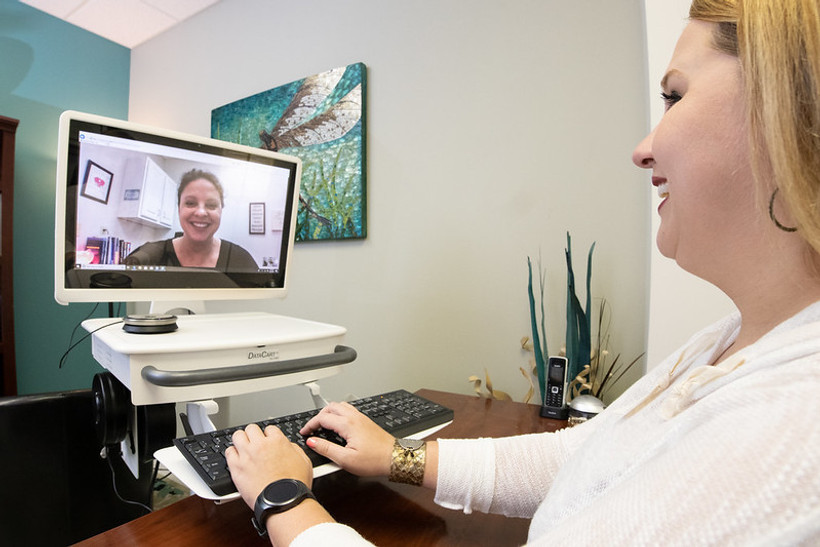State Expansion of Remote Mental Health Care Provides Lifeline for Low-Income New Yorkers
In the first year of the pandemic, four out of five appointments at state-licensed clinics were held virtually—allowing providers to tackle long-standing barriers.

When Covid-19 hit New York two years ago, state regulators added remote psychiatric care to the list of services covered by Medicaid, giving nearly a half-million low-income New Yorkers the option to access treatment from their homes.
The program has since flourished. In the first year of the pandemic, four out of five appointments at state-licensed clinics were held virtually, according to data provided to New York Focus by the state Office of Mental Health—compared to just 1 out of 500 appointments in the year before the pandemic. Meanwhile, the total number of visits to these clinics rose by 13 percent. In total, the state-licensed clinics – where more than two-thirds of the clients are on Medicaid – held 5.6 million sessions in the first twelve months of the pandemic, including 4.4 million remote sessions.
Providers say telehealth not only allowed them to continue seeing patients throughout the worst months of Covid-19, but also bypassed longstanding barriers to mental health care for the poorest New Yorkers, like childcare, transportation, and work obligations.
"For families where coming into the clinic was never a possibility, families with medically-fragile [children]...or families where there might be a single parent with no childcare, they are [now] able to log on to telehealth every week," said Dr. Ashley Golub, Director of Psychological Services at New Alternatives for Children, a nonprofit child welfare organization in New York City.
But the new modes of care in the home have raised concerns around privacy and digital literacy, and persistent disparities in connectivity are reproducing old inequities.
Before the pandemic, remote mental health care had long been hindered by state restrictions on the types of services, technologies, clinicians, and settings that could be covered. Providers had urged the state to ease those restrictions for years, but it took the pandemic for regulators to agree.
In his State of the State agenda last year, former Governor Andrew Cuomo said New York would require Medicaid to cover "high-value, medically appropriate telehealth services," raising providers’ hope that the state would support remote mental health care into the future.
Governor Kathy Hochul and Office of Mental Health Commissioner Ann Marie Sullivan, a holdover from the Cuomo administration, both have the power to ease Medicaid restrictions on telehealth. So far, clinics have been covered under an emergency waiver—but the Office of Mental Health is preparing to adopt the rule permanently, a spokesperson said.
Close to two-thirds of New York's state-licensed clinics – 276 – have already received permanent approval for remote services. The Office of Mental Health declined to say how many clients were enrolled in clinics that have not gotten permanent approval.
"We waived the standard approval process during the height of the pandemic to allow providers to make an immediate transition," wrote spokesperson James Plastiras in an email. "Now, we’re expecting them to make permanent changes so their practices are consistent with revised regulations, now and ongoing for the future."
Fewer no-shows
No-show rates have always been high at state-licensed mental health providers, also known as Article 31 clinics, but sources say they've fallen as telehealth has expanded.
Orlando Mendoza works as the assistant director of health services at Catholic Guardian Services, which operates an Article 31 clinic with roughly 160 clients in New York City. Almost all of the clients are covered by Medicaid, and Mendoza estimated roughly 70 percent are utilizing telehealth. The clinic’s telehealth policy has been "instrumental in helping the clinic reach very hard-to-reach populations," he said.
Mendoza gave the example of a mother and three children who live in the Bronx, an hour’s bus ride from the Catholic Guardian clinic. Given how expensive child care is, in order to get one child to an in-person appointment, the mother would "have to, in essence, take her whole family to the clinic." Now the whole session can be done from home.
Brian Baldwin, a private consultant who works with Article 31 clinics and the Office of Mental Health, estimated that before the pandemic, between a quarter and a third of clients would miss or cancel visits pre-pandemic. A June 2020 survey of Article 31 clients and other Medicaid recipients from Clinicians in Child Welfare found telehealth "improved many participants’ ability to make and keep appointments," particularly by eliminating the need to travel.
"We have seen a major reduction in no-shows," said Golub, the family psychologist.
Missing appointments can have collateral consequences, especially for people involved in the child welfare and criminal legal system. For birth parents who have a child in foster care, being reunited often entails a daunting system of court-ordered appointments – for individual therapy, family therapy, anger management, their kids' medical appointments, talking to their therapists – that would be difficult for any parent to manage.
"They are asked to do things that make it impossible to hold a job, that make it impossible for them to keep up with their own drug treatments or other needs," Golub said. "They can't attend to [them] because they’re being asked to jump through all these hoops… so having [telehealth] as an option just opens up the door in such an obvious way."
Felix Guzman, a community organizer, said he has been remotely seeing four practitioners to help him manage his post-traumatic stress disorder, which he developed after periods of homelessness, incarceration, and domestic violence. To receive supplemental income for a disability through Social Security, Guzman must see a Medicaid-covered psychiatrist monthly to manage his medication.
"I've been able to normalize my schedule a bit, and also my life, as I'm able to connect with mental health services at leisure," he told New York Focus.
'Impeded treatment'
A 2020 survey of clients across the mental health system (not limited to Article 31 clinics) found 70% of telehealth users were satisfied with it. In another survey from the same period conducted by Clinicians in Child Welfare, a consortium of New York providers, most respondents in Medicaid programs, including mental health clinics, reported that they felt their telehealth care was high-quality.
Still, virtual psychiatry has its drawbacks—and providers are quick to note that for many patients, it cannot replace in-person therapy. A significant portion of Medicaid patients have limited internet and technology access, or don’t have much private space. Others have developmental and intellectual disabilities that make remote treatment a poor fit. For some patients, in-person health care is more effective and leads to deeper engagement than telehealth does.
The emergency waiver only allows clinics to use telehealth when it is “clinically appropriate” and requires them to offer in-person services when a patient requests them. However, an audit by the State Comptroller's Office found that the Office of Mental Health does not have procedures in place for monitoring this requirement after clinics are first approved for telehealth.
Even proponents of telehealth acknowledge its limitations. Having fewer no-shows "definitely helps the bottom line," one clinic administrator said, but virtual sessions will not fully replace in-person care. Golub said that some New Yorkers on the autism spectrum feel safer staying home, but “for others it has impeded treatment.”
The solution may be a hybrid model, which offers both telehealth and in-person treatments.
Article 31 clinics aren't the only Medicaid service that went virtual during the pandemic. Home and community-based services and health homes, two major state Medicaid programs, have been using a hybrid model of in-person and remote treatments, which providers say have allowed them to tailor the service format to the needs of clients.
"When we went completely virtual, many of our autistic or developmentally delayed clients went without services for that period of time," said Kris Claphan, who runs New Alternatives' HCBS program.
That changed in the pandemic’s second year, when New Alternatives began to use a hybrid model. “What it has done for the clients is provide more flexibility," Claphan said. "We still see ourselves as an in-home, in-person service program because there are so many benefits of being in the community.”
The shift to remote mental health care has also highlighted the state’s digital divide. According to research from a state task force empanelled by Cuomo and chaired by former Google CEO Eric Schmidt, both Black and Hispanic households were more than twice as likely to lack a broadband subscription than non-Hispanic white households. Hochul has said she wants to tackle that by investing $1 billion in public and private funding in broadband connectivity.
Assembly Member Aileen Gunther, chair of the committee on mental health, who represents a rural part of Sullivan County in upstate New York, told New York Focus she would push Hochul and Sullivan to make audio-only phone therapy permanently covered under Medicaid as a way to bring services to internet deserts. "A lot of our folks do not have access to internet [service]. They cannot do it," she said.
Even when clients do have digital access, it can be a challenge to find a personal space in a crowded home or a homeless shelter.
"I’ve certainly heard stories where people are going to the bathroom to have sessions so they can have some privacy," said Dr. David Goldstein, COO of New Alternatives for Children and board member of the Council of Family and Child Caring Agencies, which represents New York's nonprofit family services organizations. "Figuring out the confidentiality and privacy aspects of it has been challenging."
In "a chaotic disruptive household, meaning there's not a quiet space for the child to be able to speak, then we're going to say, 'Okay, this is not going to work out, we're going to have to have you come in,'" said Mendoza, of Catholic Guardian.
In many ways, the pandemic has turned life inside out. Remote mental health care offers clinicians a window into clients' home lives that can function as a double-edged sword: it gives providers valuable insight into clients' wellbeing, but can also be an unwanted intrusion, especially for individuals for whom treatment has been court ordered.
"When they get dressed, put their makeup on, take the train to your office, they’re putting their best foot forward in a lot of ways," said one clinician.
That is not the case for telehealth, which brings the treatment setting into a person’s living space. "It's just a reminder that I'm not seen as an individual when I'm receiving services in an institutional setting," said Guzman, the community organizer.
With a call-in option, clients – if they have the time, space, and connectivity – are able to see a therapist in their own environment, in their neighborhood and amongst their milieu. Mendoza, of Catholioc Guardian, said that ease of access has been critical for getting children to start treatment.
“With the ability of just clicking a button, it enables them to actually [say], ‘OK, let me just try this,’” he said. “That's how the trust relationship between them and the therapist starts to develop, which in turn helps them dig into those real closed doors that they never really let anyone in.”


